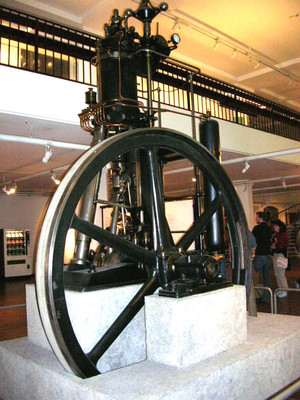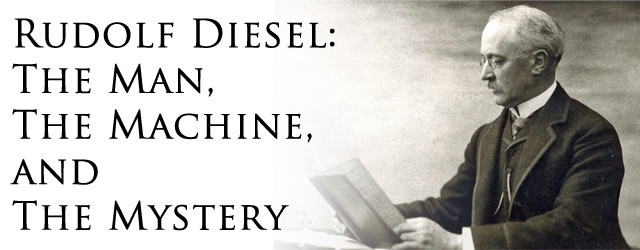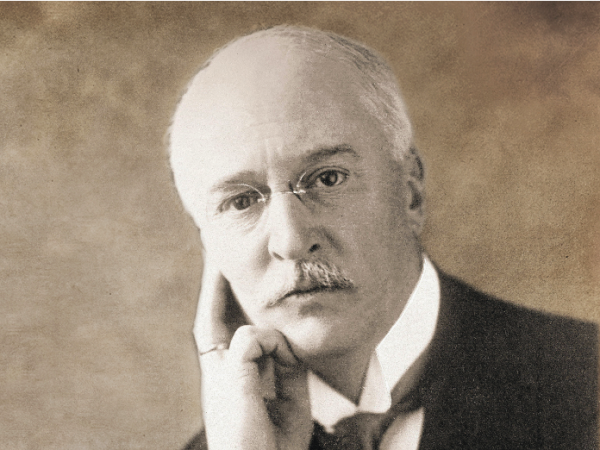Rudolf Diesel was an important man of his time. It was his relentless pursuit to create the most thermally efficient powerplant that gave birth to the diesel motor. That motor, upon which is his legacy manifested into physical form, left a lasting fingerprint on the industrial and automotive world.
We are not trying to be overly dramatic, but if Diesel had not created the engine now known as the ‘Diesel’ none of us would be reading this today. Why? Because there simply wouldn’t be an automotive subculture dedicated to the ‘coal rolling’ motor we all know and love. This makes Diesel the man a very significant person to the Diesel Army and its soldiers.
The Man
Rudolf Christian Karl Diesel was born March 18, 1858 in Paris to Bavarian immigrants Elise née Strobel and Theodor Diesel. The Diesel family lived in Paris until 1870, the year they were forced out of France at the onset of the Franco-Prussian war. The family eventually resettled in England, but Diesel was sent to Augsburg, Bavaria (now part of Germany) to live with relatives who were in a better financial position to meet the needs of a young child.
An early fascination with all things mechanical was stoked at a young age by many visits to the National Conservatory of Arts and Crafts1 [3]. At 14, Diesel knew that he would only be happy educated and employed as an engineer, and after earning top marks in grade school, enrolled into the New Industrial School of Augsburg2 [4].
 [5]
[5]A ship named After Rudolf Diesel. (Photo courtesy of ShipSpotting.com [6])
To the ire of his his parents — his father a book binder, and mother a leather goods manufacturer — Diesel did not immediately enter into the workforce when his post secondary studies were completed. Instead, he accepted a scholarship to the Royal Bavarian Polytechnic of Munich, Germany. While enrolled, he was forced to take a hiatus from studies when one of his professors fell ill with Typhoid fever. During this time Diesel gained practical engineering experience working at Sulzer Brothers Machine Works in Winterthur, Switzerland3 [7], before returning to school and graduating in 1880 with top honors3 [8].
Three years after graduation Diesel married Martha, and together they had three children; Rudolf Jr., Heddy, and Eugen. In 1890, the family moved to Berlin where Diesel took a management job at Linde’s corporate research and development4 [8].
The Machine
 [9]
[9]The Diesel Family; Rudolph, Eugen, Martha, Heddy
and Rudolph Jr., in 1900. (Photo courtesy of Diesel Duck [10])
Diesel was, by all accounts, obsessed with the theoretical and practical limitations of fuel efficiency and thermal dynamics. He theorized creating an engine that was more efficient than the popular steam engines of the time would greatly benefit small businesses. With higher profit margins larger corporations could afford to run steam engines, but the operating costs of an inefficient steam-powered motors severely set back smaller companies with much thinner profit margins.
Inspired by work of Sadi Carnot, specifically the Carnot cycle which focused on thermal efficiency, Diesel conducted several experiments with a variety of different designs5 [11]. One such experiment led him to create a steam engine that used ammonia in its power making process. Unfortunately this engine exploded during testing, almost killing him. After an extended period in the hospital Diesel recovered, but not without having his vision permanently effected. He perservered and continued to work at improving driving efficiency with several more innovative designs, at one point even designing a solar-powered engine.6 [12].
 [13]
[13]A rudimentary diesel engine. (Photo courtesy of Glued Ideas [14])
His largest breakthrough came was in the field of internal combustion, and in 1890 Diesel discovered n approach that used fuel injected at the end of the compression cycle. That fuel was then ignited by high air temperature caused by the compression stroke. The pressure ignition stroke made this motor a significant departure from standard internal combustion engines that needed a spark to ignite the air/fuel mixture7 [15].
 [16]
[16]Diesel’s 1897 diesel engine that converted 26.8 percent of the heat contained in the fuel to power. (photo courtesy of Google Images)
Early in 1893, Diesel published a paper describing this engine and by August of the same year he created the first working model — a single cylinder example 10 feet in length. He spent more than two years refining the design, now dubbed the diesel engine5 [11].
With the support of several German firms, Diesel demonstrated a 25 horsepower, four-stroke, diesel engine in 1897. His most refined model to date, it had a theoretical efficiency of 75 percent which, compared to the 10 percent efficiency of steam engines of the time, was a significant breakthrough. This motor had a fuel consumption per hp/hr ratio of 238 g which meant 26.8 percent of the heat contained in the fuel was converted into effective power.
Simple in design, very efficient, and extremely reliable, the diesel engine almost became a commercial triumph overnight after being displayed at the 1898 Munich Exhibition. Today, the diesel motor remains the most efficient internal combustion engine ever invented.
While he set out originally to help the ‘little guy’ Diesel’s inventions benefited large scale industrialists the most. Owning the patents to this design Diesel became quite wealthy for a period as additional useful applications for his motor were found in a myriad of industries.
The Mystery
 [17]The day of his death, Sept. 29, 1913 Diesel boarded ‘The Dresden,’ a Post Office steamer enroute to London, where he was set to attend the ground-breaking ceremony of the Consolidated Diesel Manufacturing Company. Afterward, Diesel was to meet with the British Navy to discuss using his engine in their fleet of submarines. During the first night of the voyage Diesel had dinner aboard the ship and left instructions from the crew at 10:00 p.m. to awake him in his quarters at 6:15 a.m. the next morning. It was the last time anyone saw Diesel alive8 [18].
[17]The day of his death, Sept. 29, 1913 Diesel boarded ‘The Dresden,’ a Post Office steamer enroute to London, where he was set to attend the ground-breaking ceremony of the Consolidated Diesel Manufacturing Company. Afterward, Diesel was to meet with the British Navy to discuss using his engine in their fleet of submarines. During the first night of the voyage Diesel had dinner aboard the ship and left instructions from the crew at 10:00 p.m. to awake him in his quarters at 6:15 a.m. the next morning. It was the last time anyone saw Diesel alive8 [18].
On the morning of September 30, when the crew arrived at his stateroom as instructed, Diesel had seemingly vanished, and was no where to be found on the ship. His bed appeared to have not to been slept in, and his night clothes were neatly folded near the bed.
His body was recovered 10 days later floating partially decomposed in the water3 [7] and was identified by his pocket knife, identification card, and eyeglass case. Judges presiding over the mysterious case deemed Diesel’s death a suicide, in a ruling that was based on current money woes, prior nervous breakdowns, and history of somewhat erratic behavior9 [19].
Many countered that Diesel’s death was murder, citing possible espionage related to his dealings with Naval fleet power, however there is truly no way of knowing what really happened that night, leaving us with a mysterious end to the life of a brilliant man whose blueprints to the highly efficient diesel engine will live on.
Sources
- Rudolf Diesel NNBB [20]
- Automotive Engineer [21]
- Rudolf Diesel Famous Scientists [22]
- Rudolf Diesel – Legends Hub [23]
- Famous Scientist [22]
- Diesel Duck [24]
- This Month In Physics History – APS.ORG [25]
- Encylopedia.com [26]
- History.com [27]NNDB [20]

